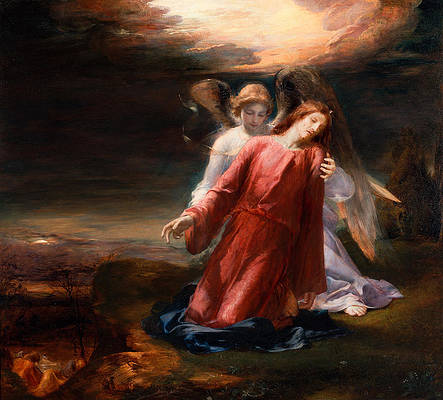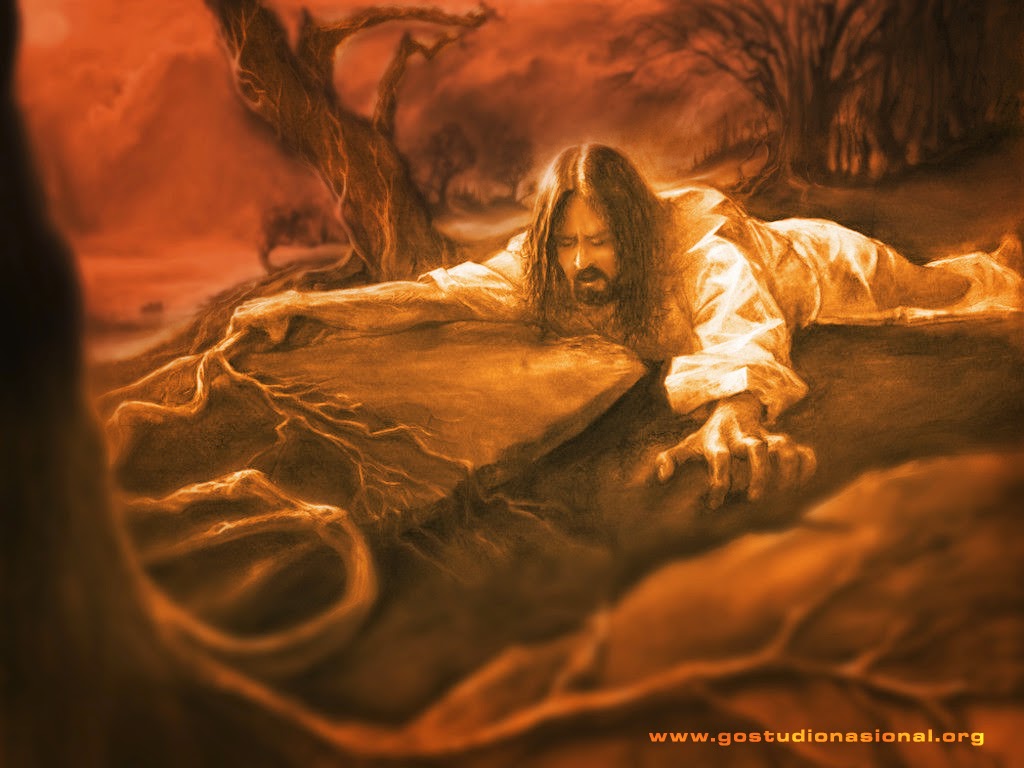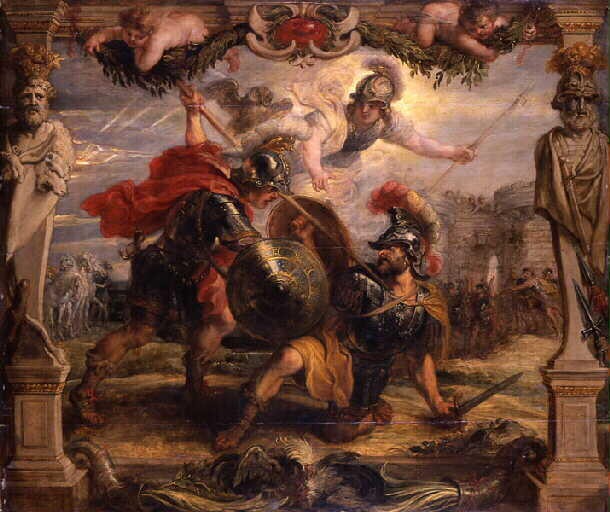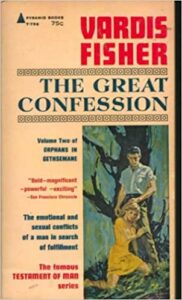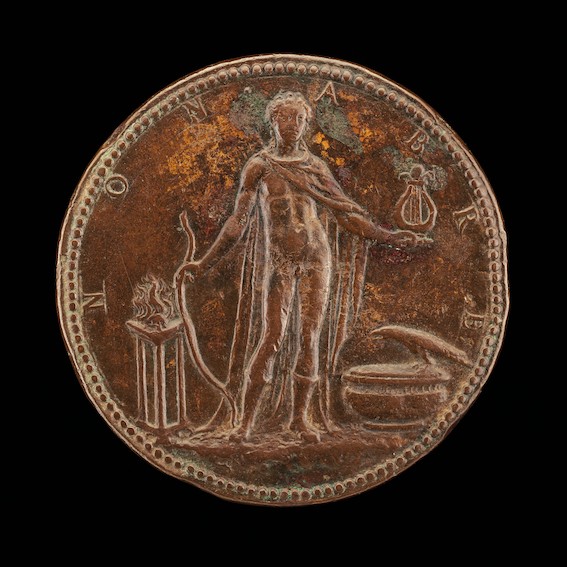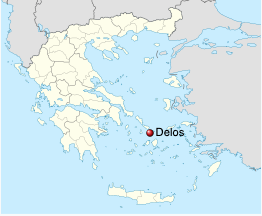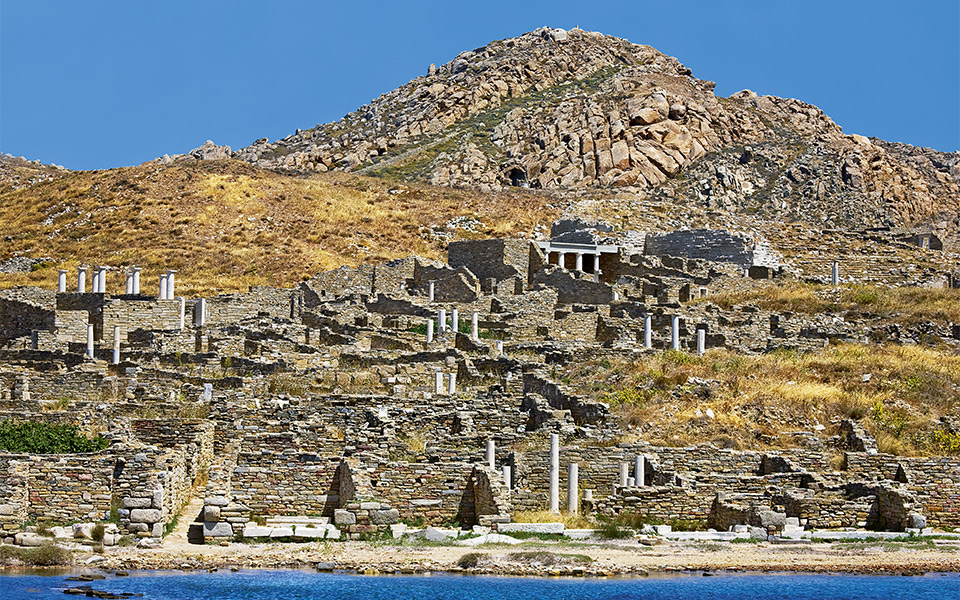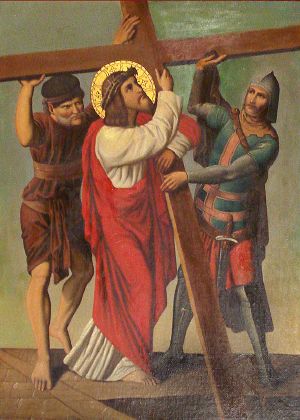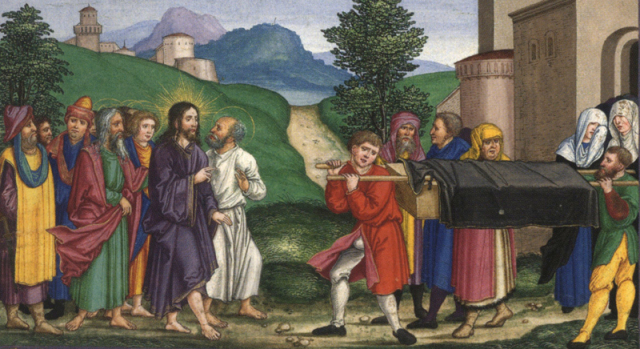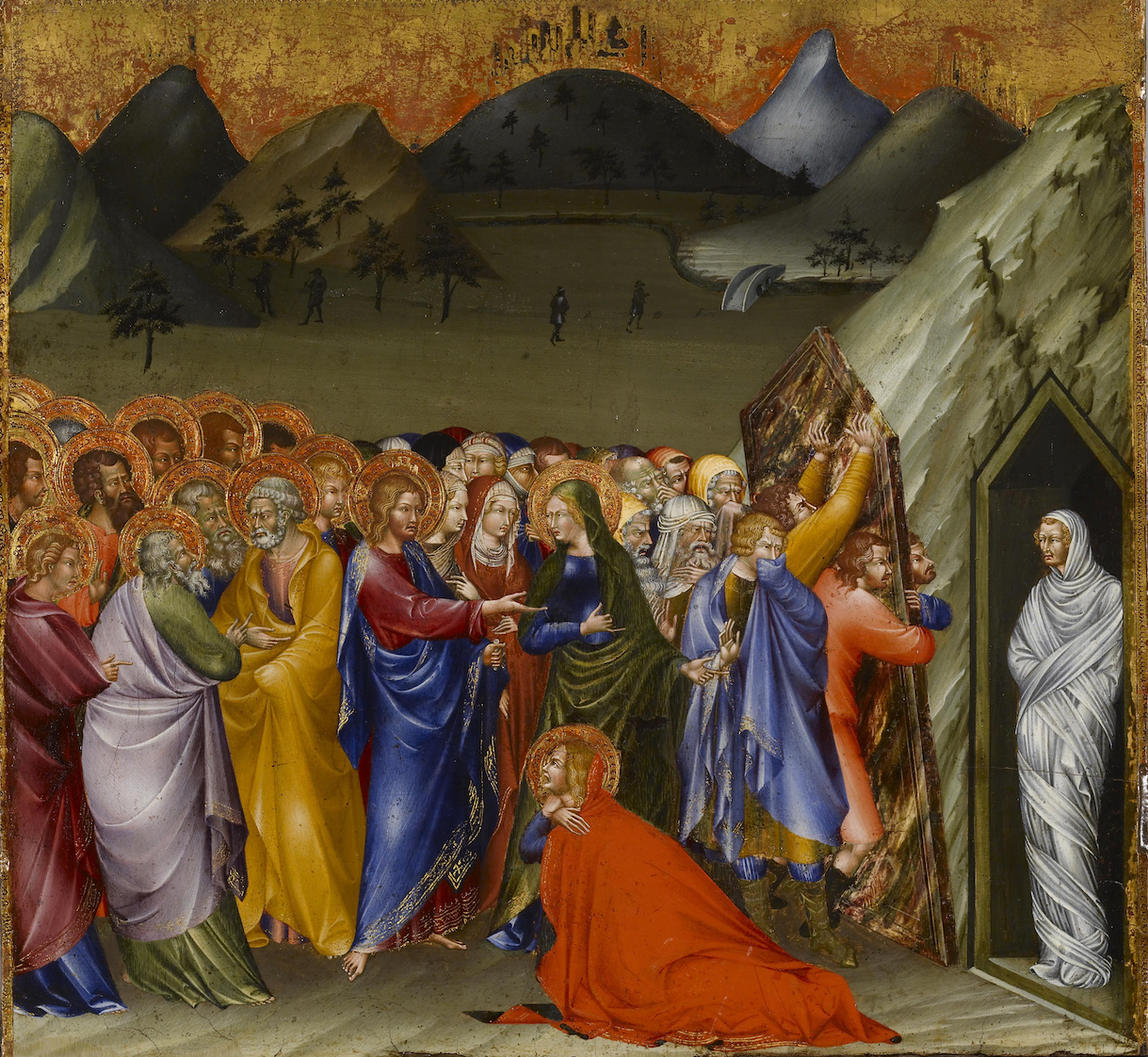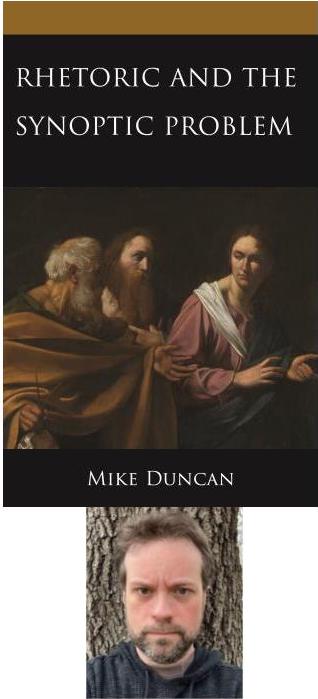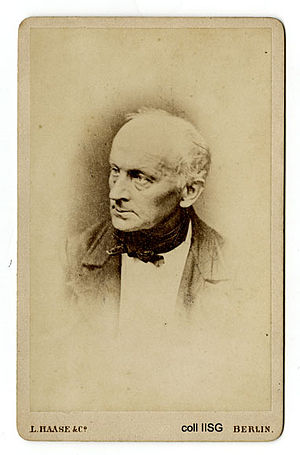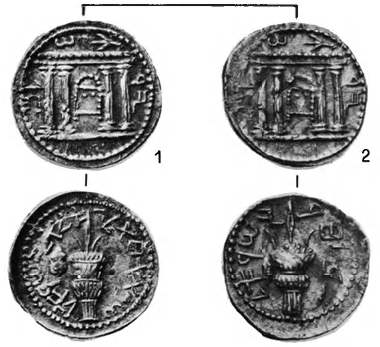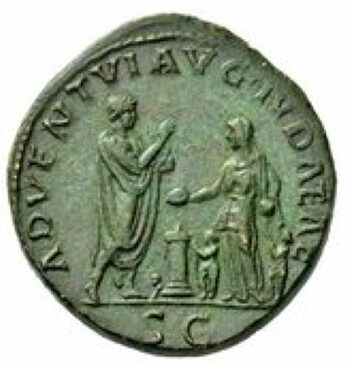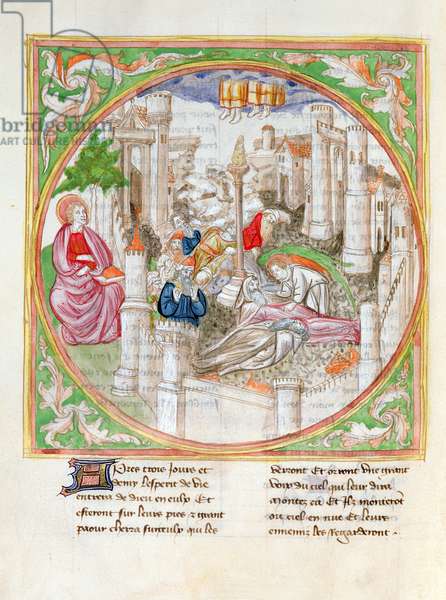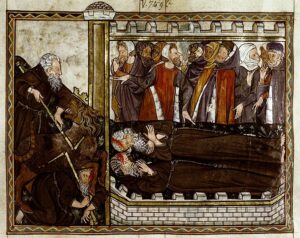| 108 |
1.
Der Einzug in Jerusalem
|
1.
The Entry into Jerusalem
|
| 108 |
Woher weiß es Jesus, als er zu seinem feierlichen Einzugs in Jerusalem Anstalten trifft, daß dieselben nicht unnütz seyn werden?
Sein feierlicher Einzug in Jerusalem ist von ihm von vornherein beabsichtigt — seine Absicht ist so ernstlich, er selbst seiner Sache so gewiß, daß er das Thier, dessen er be-darf, den Esel, auf dem er als der verheißene König Zions einziehen will, durch ein Wunder herbeischasst — woher weiß er es aber, daß die Dekoration nicht fehlen werde, ohne die sein Ritt auf jenem Thier allen Effect entbehren würde? — woher weiß er es, daß die Volksmenge ihm entgegen kommen, Baum-zweige auf den Weg streuen und ihn mit dem Rufe: gesegnet sey, der da kommt im Namen des Herrn! in die Stadt geleiten werde? |
How does Jesus know, when he makes preparations for his solemn entry into Jerusalem, that they will not be in vain?
His solemn entry into Jerusalem is intended by him from the start – his intention is so serious, he himself is so sure of his cause that he miraculously brings about the animal he needs, the donkey, on which he wants to enter as the promised King of Zion – but how does he know that the ceremony will not be lacking, without which his ride on that animal would lack all effect? – How does he know that the crowd will come to meet him, scatter branches of trees on the way and escort him into the city with the cry: Blessed is he who comes in the name of the Lord! |
| 108/109 |
Und die Menge — woher kommt ihr auf einmal die Gewißheit, daß dieser Mann auf seinem Esel ihr verheißener König sey? Bis jetzt hat sich Jesus vor dem Volke noch nicht als Messias bekannt — ja, als die Jünger am Schluß seiner galiläischen Wirksamkeit hinter das Geheimniß seiner Messianität kamen, verbot er ihnen streng, den Leuten zu sagen, wer er sey — woher kennt ihn also die Volksmenge von Jerusalem — woher kommt ihr der Gedanke, ihm entgegen zu ziehen und ihn in die heilige Stadt einzuführen? |
And the crowd – where did they suddenly get the certainty that this man on his donkey was their promised king? Until now Jesus has not confessed himself to the people as Messiah – yes, when the disciples discovered the secret of his Messiahship at the end of his Galilean ministry, he strictly forbade them to tell the people who he was – so how does the crowd of Jerusalem know him – where does the idea come from to meet him and introduce him into the holy city? |
| 109 |
Und als die Jünger nach dem Geheiß ihres Herrn in dem Flecken den beschriebenen Esel fanden und losbanden, woher kommt es, daß jene Leute, die nicht begreifen konnten, wie die Jünger dazu kamen, sich an fremdem Eigenthum zu vergreifen, durch Ein Wort, durch die Formel: „der Herr bedarf sein!” sich zufrieden stellen lassen? — woher kommt es, daß das Eine Wort „Herr”, während sie den Herrn selbst noch nicht kannten, sie zur Ruhe brachte?
Alle diese Schwierigkeiten und Widersprüche hat der Prag-matismus des Urevangelium- erzeugt — also auch in vorau-geebnet und gelöst. Der letzte Kampf, die Vollendung der Kollision und die schließliche Herbeiführung der Katastrophe fordern die Voraussetzung, daß Jesus offen als Messias aufgetreten und als solcher anerkannt ist — daher der feierliche Einzug in Jerusalem mit allen Widersprüchen, die in ihm selbst und in seiner Vorbereitung liegen — daher auch der Blinder der als Vorposten der begeisterten Menge der Hauptstadt zu Jericho austritt *). |
And when the disciples, at the command of their Lord, found the donkey in the village and untied it, how is it that those people, who could not understand how the disciples came to take possession of other people’s property, let themselves be satisfied by one word, by the formula: “the Lord needs to be! – Where did it come from that the One Word “Lord”, while they did not yet know the Lord Himself, brought them to rest?
All these difficulties and contradictions have been created by the pragmatism of the primal gospel, and have thus also been anticipated and solved. The final struggle, the completion of the conflict and the eventual bringing about of the catastrophe demand the prerequisite that Jesus openly appeared as Messiah and was recognised as such – hence the solemn entry into Jerusalem with all the contradictions that lie in it and in its preparation – hence also the blind man who exits as the outpost of the enthusiastic crowd of the capital at Jericho *). |
| 109* |
*) Wenn es noch im jetzigen Marcusevangelium, in der Mitte des Bericht« (E. 10, 49), heißt: die Lenke „riefen den Blinden”, so be-weist diese Wendung, daß der Mann im Anfang« des Berichts nur als »ein Blinder” (τυφλὸς τις) bezeichnet war. Erst der Ueberarbeiter der Urevangeliums, der Urheber des jetzigen Marcusevangelium, hat den Zusatz und die falsche Bestimmtheit: „der Sohn des Timänn, Barttmäus, der Blinde” (V. 46) eingeschoben — ein Zusah, dessen UngehöriM sich auch daraus erweist, daS er die folgende Bestimmung, der Man« habe bettelnd am Wege gesessen, überflüssig machte. Im Urevangelium hieß es nur: „eia Blinder sag am Weg« und bettelte.” |
*) “If in the current Gospel of Mark, it still says in the middle of the account (ch. 10, 49) that the people “called the blind man,” this phrase proves that the man was only referred to as “a blind man” (τυφλὸς τις) at the beginning of the account. It was only the reviser of the original Gospel, the author of the current Gospel of Mark, who inserted the addition and the false specification: “the son of Timaeus, Bartimaeus, the blind man” (v. 46) – an addition that is shown to be inappropriate by the fact that it made the following specification, that the man was begging by the roadside, redundant. In the original Gospel, it only said: “a blind man sat by the roadside and begged.” |
| 110 |
Nach der Beschreibung, die Epiphanias von Marclon-Evangelium gibt, hat Urlukas die beiden Erzählung-stücke von dem Einzug in Jerusalem und von der Tempelreinigung (C. 19, 29—46) ausgelassen.
Ausgelassen — denn daß er durch sein Verfahren einen Typus, der Jesum wirklich nach Jerusalem kommen ließ und sein erstes Auftreten in der Hauptstadt schilderte, lückenhaft und haltlos gemacht hat, kann er selbst nicht läugnen, wenn er auf die Notiz (C. 19, 28), daß Jesus (von Jericho) weiter zog und die Reise nach Jerusalem fortsetzte, sogleich da- fertige Factum folge« läßt, daß Jesus sich täglich mit Lehren im Tempel beschäftigte.
Mit überlegter Absicht ausgelassen — denn kurz vorher hat er den Herrn den Satz aufstellen lassen, daß das Reich Gottes im Jnnrrn der Gläubigen waltet (C. 17, 21), — ja läßt er ihn sogar mit ausdrücklicher Beziehung darauf, daß er nahe bei Jerusalem war und sie — (sie überhaupt!) — meinten, daß das Reich Gottes auf der Stelle offenbar werden sollte (C. 19, 11), in Jericho die Parabel von den Talenten vor« tragen. Jst das Reich Gottes ein inwendiges, so wäre der Pomp des Einzuges in Jerusalem sehr ungehörig gewesen — hat Jesus auf der letzten Station vor Jerusalem sich gegen die voreilige Erwartung des Reiches Gottes erklärt, so durfte er nicht den Augenblick darauf durch den Antritt seiner königlichen Herrschaft seine Erklärung widerrufen. |
According to the description given by Epiphanias of Marclon’s Gospel, Urlukas omitted the two narrative pieces of the entry into Jerusalem and of the cleansing of the temple (C. 19, 29-46).
Omitted – for he himself cannot deny that by his procedure he has made incomplete and untenable a type which really had Jesus come to Jerusalem and described his first appearance in the capital, when he immediately “follows” the note (C. 19, 28) that Jesus moved on (from Jericho) and continued the journey to Jerusalem with the finished fact that Jesus occupied himself daily with teaching in the temple.
With deliberate intent he omits – for shortly before he had the Lord establish the proposition that the kingdom of God reigns in the hearts of the faithful (C. 17, 21), – yes, he even has him recite the parable of the talents in Jericho with explicit reference to the fact that he was near Jerusalem and that they – (they at all!) – thought that the kingdom of God should be revealed on the spot (C. 19, 11). If the kingdom of God is internal, the pomp of the entry into Jerusalem would have been very unseemly – if Jesus, at the last station before Jerusalem, declared himself against the premature expectation of the kingdom of God, he was not allowed to revoke his declaration the moment after by taking up his royal reign. |
| 110/111 |
Zeugt aber gegen Urlukas die Lücke, die er unvorsichtig genug zwischen der Reise nach Jerusalem und dem wirklichen Aufenthalt daselbst offen ließ, so werden seine vorbereitenden Vorbemerkungen, die stillschweigend den Bericht vom Einzug in Jerusalem erstiaen sollen, von ihrer Umgebung selbst zurüage-wiesen und als verunglückter Nothbehelf widerlegt. |
But if the gap which he carelessly enough left open between the journey to Jerusalem and the actual stay there testifies against Urluke, then his preparatory preliminary remarks, which are supposed to tacitly cover the report of the entry into Jerusalem, are themselves rejected by their surroundings and refuted as an unfortunate stopgap. |
| 111 |
Daß das Reich Gottes ein inwendiges sey*), soll Je-sus auf die Frage der Pharisäer, wann das Reich Gottes komme, erwidert haben — welche Antwort also! Die Phari-särr fragen nach der Zeit, wann das Reich Gottes eintreffen werde, und Jesus behandelt in seiner Antwort den Gegensatz des Jnnerlichen und Aeußerlichrn — hat diesen Gegen-satz wenigens im Auge, wenn er dem Reich Gottes die Aeußer-lichkeit abspricht! Als Eingang zu diesem Spruch stellt er da« gegen den Satz auf, daß das Kommen des Reiches Gottes kein Gegenstand der Beobachtung sey — spricht er also doch von der Zeit — setzt er das Kommen des Reiches als gewiß, als zukünftig voraus und verneint er nur die Vorstellung, daß man dieses Kommen berechnen und beobachten könne — und unmittelbar darauf? (C. 17, 22—37) — folgt eine jener Anticipationen der Rede Jesu über seine Wiederkunft, — eine jener Anticipationen, die Urlukas in jenem unförmlichen Reise-bericht zusammengehäuft hat — die Ausführung des Gedankens, daß die Wiederkunft des Menschensohnes eine plötzliche und eine unerwartete seyn werde. |
That the kingdom of God is internal*), Jesus is said to have answered the question of the Pharisees, when the kingdom of God will come – so what an answer! The Pharisees ask about the time when the kingdom of God will come, and in his answer Jesus deals with the contrast between the internal and the external – he has this contrast in mind when he denies the external nature of the kingdom of God! As an introduction to this saying he sets up “there” against the proposition that the coming of the kingdom of God is not an object of observation – does he therefore speak of time – does he presuppose the coming of the kingdom as certain, as future, and does he only deny the idea that this coming can be calculated and observed – and immediately afterwards? (C. 17, 22-37) – follows one of those anticipations of Jesus’ speech about His return, – one of those anticipations which Urlukas has heaped together in that shapeless travelogue – the execution of the thought that the return of the Son of Man will be a sudden and unexpected one. |
| 111* |
*) ἐντὸς ὑμῶν |
*) ἐντὸς ὑμῶν |
| 111/112 |
Urlukas hat also sehr Unrecht daran gethan, jenen Spruch von der innerlichen Natur des Reiches Gottes in diese Rede über das Plötzliche der Wiederkunft des Menschen-sohns einzufügen, und es konnte ihm auch nichts helfen, wenn er sein Versehen dadurch zu vertuschen und den Schein der Zusammengehörigkeit zu erzeugen glaubte, daß er dem Spruch von der innerlichen Natur des Gottesreichs dieselbe Warnung und Wendung voranstellte, die nachher wiederkehrt, nachher aber nur (V. 23) an ihrer Stelle ist, wenn es gilt die Verführer zu schildern, die vor der Zeit schon den wiedergekommenen Menschensohn zeigen wollen. Dieser Formel: „sie werden zu euch sagen, siehe hier! siehe da!” hat er sogar, weil auch der vorhergehende Satz: „nicht kommt das Reich Gottes”…. mit einer Verneinung anfängt, (V. 21) die ungelenke und unpassende Form gegeben: „nicht werden sie zu euch sagen”… |
Urluke was therefore very wrong to insert the saying about the inward nature of the kingdom of God into this speech about the sudden return of the Son of Man, and it could not help him if he thought he could cover up his oversight and create the appearance of coherence by prefixing the saying about the inward nature of the kingdom of God with the same warning and turn of phrase that returns later, but is only used in its place (v. 23) when it is necessary to describe the deceivers who want to show the Son of Man returning before the end of time. 23) in its place, when it is necessary to describe the deceivers who want to show the returned Son of Man before the time. To this formula: “they will say to you, look here! look there!” he even gave (v. 21) the awkward and inappropriate form: “they will not say to you” because the previous sentence: “the kingdom of God is not coming”…. also begins with a negation…. |
| 112 |
Und die Parabel von den Talenten soll der Leser wirklich als eine Widerlegung und Belehrung derjenigen ansehen, die auf der Stelle schon die Offenbarung des Reiches Gottes erwarteten? Welche Zumuthung! Sie kennt nur die Eine Moral, daß dem, der da hat, gegeben, dem, der da nicht hat, auch was er hat, genommen wird. Nur der für die Moral des Ganzen unwesentliche Nebenzug, daß der Herr der Knechte, ehe er dieselben mit den Talenten ausstattet, verreist und nachher zurückkehrt, hat Urlukas dazu verführt, den Vertrag der Parabel durch jene Erwartung zu veranlassen, d. h. sie an so un-passender Stelle anzubringen.
Diese Lütte ist also nicht mehr gerechtfertigt und sie muß wieder ausgefüllt werden — aber nur durch den Urbericht, nicht durch die Darstellung des Einzuges, den der Compilator des jetzigen Lukasevangeliums sammt der Tempelreinigung wieder zu Gnaden angenommen hat.
Richt die Jünger dürfen, wie dieser es haben will (Luk. 19, 35. 36), nachdem sie ihre Kleider auf den Esel gelegt haben, ihre Kleider auch noch auf den Weg breiten — sondern das muß, wie es im Urbericht geschieht, ein Theil der Volksmenge thun, während der andere Theil Zweige von den Bäumen bricht und sie auf den Weg streut. |
And should the reader really regard the parable of the talents as a refutation and instruction of those who expected the revelation of the Kingdom of God right away? What impertinence! It knows only one morality, that to him who has shall be given, and from him who has not shall be taken away what he has. Only the incidental feature, which is not essential to the morality of the whole, that the master of the servants, before he endows them with the talents, goes away and returns afterwards, has seduced Urlukas to induce the contract of the parable by this expectation, i.e. to place it in such an inappropriate place.
This lie is therefore no longer justified, and it must be filled in again – but only by the original account, not by the representation of the entrance, which the compiler of the present Gospel of Luke has again accepted with grace, together with the cleansing of the temple.
The disciples were not allowed to spread their garments on the road after they had put them on the donkey, as the author wanted (Luk 19, 35. 36), but rather, as in the original account, a part of the crowd had to do so, while the other part broke branches from the trees and scattered them on the road. |
| 113 |
Nicht „der ganze Haufe der Jünger” (B. 37) kann dem lobpreisenden Zug bilden, denn man weiß nicht, woher auf ein-mal diese vertraute Jüngerschaar kommt — sondern das Volk, das seinen König erkennt, geleitet ihn in seine Stadt.
Es ist der Triumphzug des Königs, der seine Herrschaft ««tritt — es ist daher ungehörig, wenn der Compilator (Luk. 19, 37) allein an den Wunderthäter denkt und den Jubel jener Jüngerschaar aus der Menge der Wunder erklärt, die sie gesehen hatten.
Man sieht zwar noch, wie der Compilator dazu kam, die Menge der Jünger an die Stelle des Volks zu setzen: — weil nämlich das Bolk nicht „auch” — (wie jene Jünger) — be-dacht habe, was zu seinem Frieden dient, muß der Herr, als er nahe herbeikam und die Stadt sah, über ihr Ende weinen und ihren Untergang weissagen (V. 41—44) — d. h. den Freudentag trüben.
Auch das war schon unpassend, daß der Compilator vor der Bedrohung der Stadt den Zug anbrachte, daß einige Pha-risäer den Herrn aufforderten, er solle seinen Jüngern Einhalt thun, worauf derselbe antwortet: „wenn diese schweigen, so werden die Steine schreien” (V. 39. 40) — die Freude des Tages muß vollständig seyn! Vollständig und ohne Mißklang! Deshalb ist es auch unpassend, daß dieser spätere Bearbeiter des Lukasevangeliums an demselben Tage noch, sogleich nach dem Eintritt in die Stadt, die Tempelreinigung geschehen läßt. Heute ist vielmehr ein Festtag! Ein Tag des Glanzes — der Freude, die durch keinen Mißton unterbrochen werden darf. |
Not “the whole multitude of disciples” (B. 37) can form the praising procession, for one does not know where this familiar crowd of disciples comes from all at once – but the people, who recognise their king, lead him into their city.
It is the triumphant procession of the King who “treads” his reign – it is therefore improper for the compiler (Luk 19:37) to think only of the miracle-worker and to explain the rejoicing of that band of disciples from the multitude of miracles they had seen.
We can still see how the compiler came to put the multitude of disciples in the place of the people: – for because the multitude had not “also” – (like those disciples) – considered what was for their peace, the Lord, when he came near and saw the city, must weep over its end and prophesy its destruction (vv. 41-44) – i.e. cloud the day of rejoicing.
Even this was incongruous, that the compiler, before threatening the city, made the move, that some Phaisees called upon the Lord to stop His disciples, to which He replied: “if these are silent, the stones will cry out” (v. 39. 40) – the joy of the day must be complete! Complete and without discord! Therefore, it is also inappropriate that this later editor of Luke’s Gospel has the cleansing of the temple take place on the same day, immediately after the entrance into the city. Today is rather a day of celebration! A day of splendour – of joy, which must not be interrupted by a murmur. |
| 113/114 |
Auch Matthäus gibt dem Ganzen die falsche und unpassende Anordnung, daß Jesus sogleich nach dem Einzuge in den Tempel läuft und die Reinigung desselben vornimmt. Auch er las wie Lukas in einer seiner Quellenschriften von einer miß-liebjgen Bemerkung der Ober» über den Beifall, der Jesum empfing — er läßt dieselben zwar erst «ach der Tempelrei-nigung mit ihrer unzustiedenen Mahnung auftreten, muß es aber gleichwohl noch verrathen, daß diese Episode in seiner Quelle einen Bestandtheil des Einzuges bildete, da die Unzufriedenheit der Obern durch das Hosiannarufen der Kinder (!) hervorgerufen wird. Er wußte auch bereits davon, hatte darüber Etwas gelesen, daß der Jubel, der au diesem Tage Jesum umgab, durch den Anblick von Wunderthaten hervorgerufen war — er läßt deshalb sogleich nach der Tempel-reinigung — sogar noch im Tempel! — Jesum Wunder ver-richten, damit der Aerger der Obern und der Jubel der Kinder recht natürlich erklärt werde. Allein weder das Jubelgeschrei der Letzteren, noch die Bemerkung der Gegner enthält die leiseste Bezugnahme auf jene Wunder und in Beidem ist so wenig wie in der Antwort Jesu die Voraussetzung, daß das Ganze im Tempel geschieht, aufzufinden. |
Matthew also gives the wrong and inappropriate order that Jesus runs into the temple immediately after the entrance and cleanses it. Like Luke, he also read in one of his sources about a displeasing remark by the “superiors” about the applause that Jesus received – although he only lets them appear “after the temple dedication with their unpleasant admonition, he must nevertheless reveal that this episode in his source formed a part of the entry, since the dissatisfaction of the superiors is caused by the children calling out to the hosannah (!). He already knew about it, had read something about it, that the rejoicing that surrounded Jesus on that day was caused by the sight of miraculous deeds – He therefore had Jesus perform miracles immediately after the cleansing of the temple, even while still in the temple, so that the anger of the rulers and the rejoicing of the children would be explained quite naturally. But neither the rejoicing of the latter, nor the remark of the opponents contains the slightest reference to those miracles, and in both, as little as in Jesus’ answer, is the precondition that the whole thing takes place in the temple to be found. |
| 114 |
Der erste Bildner jener Episode und Variation auf die mißliebige Bemerkung der Pharisäer, die uns im Lukasevange-lium erhalten ist, hat sie, wie das Hosiannarufen beweist, in den Einzug verwebt, und wenn sie hier als ein störender Ueber-fluß vom Urbericht zurückgewiescn wird, so will dieser auch nachher, nach der Tempelreinignng, von ihr Nichts wissen, da er nach dieser nur Eine Aeußerung und Frage der Obern kennt — die Frage nach der Vollmacht, die Jesus für sein großartig gewaltthätiges Auftreten und für sein oberstrichterliches Benehmen aufzuweisen habe. |
The first author of this episode and variation on the disliked remark of the Pharisees, which is preserved for us in Luke’s Gospel, interwove it, as the calling of the Hosanna proves, into the entrance, and if it is rejected here as a disturbing overflow from the original report, the latter, after the cleansing of the temple, does not want to know anything about it, since after this he knows only one statement and question of the superiors – the question of the authority that Jesus had to show for his grandiose violent appearance and for his supreme judicial behaviour. |
| 114/115 |
Das eigne Werk des Matthäus ifl dagegen das schriftstel-lrrische Wunder, daß Jesus zu gleicher Zeit auf zwei Thieren reitend seinen Einzug hält — bewirkt hat er es dadurch, daß er die Jünger, als sie ein Eselsfüllen mit dessen Mutter herbeigebracht und ihre Kleider auf beide*) gelegt hatten, ihren Meister in Einem und demselben Augenblick« gleichfalls auf beide Thiere**) setzen läßt — das Erstere, an sich schon unnöthig, geschah unwillkührlich, weil dem Matthäus beide Thiere wichtig waren und zum Ceremoniell des Ganzen zu gehören schienen, nachdem er einmal in der Weissagung des Zacharias C. 9, 9 die beiden parallelen Bezeichnungen Eines und desselben Esels zu peinlich prosaisch als dir Bezeichnung zweier Thiere aufgefaßt hatte — das zweite, ein reines Unding, war die me-chanische Folge des Intereffes, welches er an den beiden Thieren der Weissagung nahm. Bon der Formel „auf sie” konnte er sich nicht trennen und er schrieb sie mechanisch zum zweitenmale hin, nachdem sie ihm einmal als wichtig und bedeutungsvoll erschienen war. |
Matthew’s own work, on the other hand, is the scriptural miracle of Jesus’ entrance riding on two animals at the same time – he brought this about by having the disciples, when they had brought a donkey’s colt with its mother and laid their clothes on both*), the former, in itself already unnecessary, was done involuntarily, because both animals**) were important to Matthew and seemed to belong to the ceremonial of the whole, after he once in the prophecy of Zacharias C. 9, 9 he had understood the two parallel designations of one and the same donkey too embarrassingly prosaically as the designation of two animals – the second, a pure absurdity, was the mechanical consequence of the interest he took in the two animals of the prophecy. He could not part with the formula “upon them” and wrote it down mechanically for the second time after it had once seemed important and significant to him. |
| 115* |
*) ἐπ’ αὐτῶν. |
*) ἐπ’ αὐτῶν. |
|
| 115 |
Während übrigens der Verfasser des Urberichts seiner Sache sicher ist und sich darauf verlassen ka«n, daß Jedermann in sei« ner Darstellung den verheißenen König des Zacharias sogleich erkennen werde, hat Matthäus das Ueberflüssig« gethan und noch ausdrüalich daran erinnert, daß es sich, als Jesus die Jünger nach dem Esel ausschiaie, um die Erfüllung jener Weissagung des Zacharias handelte. Er hätte auch noch darauf verweisen können, daß der Esel losgebunden werden muß und daß Jesus ausdrücklich dieß Losbinden erwähnt, weil Juda’s, des Erwählten, des Fürsten und Herrn Esel (1. Mos. 49, 11) angebunden ifl. |
Meanwhile, the author of the original account is certain of his matter and can rely on everyone recognizing the promised king of Zechariah in his portrayal. However, Matthew has done the superfluous and explicitly reminded that, when Jesus sent the disciples for the donkey, it was about the fulfillment of that prophecy of Zechariah. He could also have pointed out that the donkey must be untied and that Jesus expressly mentioned this untying because Judah’s, the chosen one’s, the prince and lord’s donkey (Gen. 49:11) was bound. |
| 115/117 |
Der Vierte endlich muß eine Darstellung vor Augen gehabt haben, die ebenso wie diejenige, die wir im jetzigen Lukasevangelium lesen, die Begristrung des Volks durch die Wunder erklärt, die es vom Herrn gesehen hatte — ein Anstoß dieser Art konnte es nur bewirken, daß er seine Geschichte von der Auferweckung des Lazarus gerade hieher setzte — ein Anstoß dieser Art mußte auf ihn gewirkt haben, als er mit seiner unbeholfenen Absichtlichkeit es hervorhob, daß die Leute, um Lazarus zu sehen, nach Bethanien hinausgingen, und als er die Leute, die Jesum beim Einzuge ———— doch was sprechen wir vom Einzuge, wenn wir die Darstellung des Vierten wikdergeben wollen — unter seiner Hand verlieren die festesten Gestalten des synoptischen Geschichtskreises ihren Halt und ihre Form — was in diesem Kreise ein bedeutsames, von Jesu selbst vorbereitetes und beabsichtigtes Ereigniß ist, wird durch die Kunst des Vierten zu einer zufälligen Begebenheit, die dem Heben, er weiß nicht wie, arrivirt — selbst die Mittel, die der Vierte zur Herbeiführung dieser Begebenheit in Bewegung fetzt, verändern im Augenblia, wenn er sie als Hebel ansetzt, ihre Gestalt und mit je größerer Absichtlichkeit er ihre Hebelkraft rühmt, um so mehr straft ihn ihre Schwächt und ihre ungeschickte Form Lügen. Erst soll das Wunder, das Jesus am Lazarus verrichtet hat, die Menge, die ihn nach Jerusalem geleitet, herbeischaffen — darum müssen Viele nach Bethanien hinausströmen, um den Ailferwraten zu sehen, und an Jesus glauben (C. 12, 11) — auf einmal aber, als man in Jerusalem hört, daß Jesus nach der Stadt kommt, muß ihm eine ganz andere Volksmasse entgegenziehen und sein zufälliges Kommen zu einem feierlichen Einzuge machen — nämlich die Volksmenge, die des Festes wegen nach Jerusalem gekommen war (V. 12) — und in demselben Augenblicke, wo man noch glaubt, daß diese Festbesucher dem Herrn als dem König Jsraels entgegencufen, bemerkt der Vierte, daß jener Volkshaufe, der dabei war, als Jesus den Lazarus er weckte, jetzt seine That verkündete, also die preisende Menge bildete (v. 17) — nein! nein! so verhielt es sich nicht! in demselben Athemzuge meldet uns der Vierte, daß die Menge, dir Jesum umgab und geleitete, durch die Nachricht von seinem Wunder am Lazarus dazu bewogen wurde, ihm entgegen zu ziehen! |
Finally, the Fourth [Evangelist] must have had a representation before his eyes which, just like the one we read in the current Gospel of Luke, explains the limitation of the people through the miracles they had seen from the Lord. Such a stimulus could only have caused him to place his story of the resurrection of Lazarus here. Such a stimulus must have acted on him when, with his clumsy intentionality, he emphasized that the people went out to Bethany to see Lazarus, and when he loses the firm shapes of the synoptic cycle of events under his hand – “But why do we talk about the entry when we want to reproduce the portrayal of the fourth [evangelist]? – under his hand, the firmest figures of the synoptic cycle of stories lose their grip and shape – What in this circle is a significant event, prepared and intended by Jesus himself, is turned by the artistry of the Fourth Gospel into a random occurrence that happens, he knows not how – Even the means that the Fourth Gospel employs to bring about this event change their shape in an instant, as soon as he sets them as levers, and with the greater intentionality he praises their leverage power, the more their weakness and clumsy form expose him as a liar. The miracle that Jesus performed on Lazarus is supposed to bring the crowd that led him to Jerusalem – therefore, many must stream out to Bethany to see the one who was raised from the dead, and believe in Jesus (John 12:11) — but all at once, when one hears in Jerusalem that Jesus is coming to the city, a completely different crowd must meet him and make his accidental coming a solemn entry – namely the crowd that had come to Jerusalem for the feast (v. 12) – And in the same moment, while people still believed that these festival-goers were going to meet the Lord as the King of Israel, the Fourth [Gospel writer] noticed that the crowd who was there when Jesus raised Lazarus now spread the word about his deed, forming the praising crowd (v. 17) – No! No! It was not like that! In the same breath, the Fourth Gospel informs us that the crowd surrounding and accompanying Jesus was moved by the news of his miracle on Lazarus to go out to meet him! |
| 117 |
Ein Geschichtsschreiber, der mit so viel Mitteln des Pragmatismus die feierliche Einholung — zur Einholung nämlich ist der Einzug geworden — herbeigeführt und erklärt hat, bedurfte des synoptischen Wunders nicht mehr, mit welchem sich Jesus den unentbehrlichen Esel verschaffte — sein Jesus findet ihn (V. 14) — findet ihn zufällig und das war genug — der Leser bedurfte keiner Erklärung dieses Zufalls, nachdem die ganze Begebenheit durch eine so zwingende und großartige Nothwendigkeit herbeigeführt war.
Der Leser brauchte es auch nicht zu wissen, wie die Pha-risäer bei dieser Gelegenheit zu ihrem Ausruf kamen: „seht ihr, daß Nichts hilft?” (L. 19). Muß denn der Vierte die ganze Quellenschrift, die er benutzte, abschreiben und dem Leser jene Episode des Einzugs, in der die Obern gleichfalls dem Jubel des Volks gewehrt wissen wollen und auf die Vergeb-lichkeit des Bemühens aufmerksam gemacht werden, voll-ständig mittheilen? Jst der Vierte nicht Meister des gegebenen Stoffs und ist es nicht genug, wenn er demselben nur zerstückelte Stichworte entlehnt? |
A historian who, with so much pragmatism, has brought about and explained the solemn reception – The entry has become a reception – no longer needed the synoptic miracle by which Jesus procured the indispensable donkey- his Jesus finds it (v. 14) – finds it by chance and that was enough – the reader did not need an explanation of this chance, after the whole event had been brought about by such a compelling and magnificent necessity.
Nor did the reader need to know how the Pharisees came to their exclamation on this occasion: “Do you see that nothing helps? (L. 19). Must the Fourth then transcribe the whole of the source scripture which he used and give the reader a complete account of that episode of the entry in which the superiors likewise want the people’s rejoicing to be resisted and are made aware of the futility of their efforts? Is the Fourth not a master of the given material and is it not enough if he only borrows fragmented key words from it? |
| 117/118 |
Am Ende soll er auch dem Leser sagen, welches der vorhergehende Tag war, mit welchem der folgende (V. 12), der der Lag der Einholung ist, in Verhältniß steht? Am Ende soll er diesen folgenden Tag, nachdem das Dauernde, daß die Juden nach Bethanien hinausflrömten, um den Lazarus zu sehen, und daß die Hohenpriester schon daran dachten, den Stein des Anstoßes, den Lazarus au- dem Wege zu räumen (B.9—11), vorangegangen war, überhaupt nur erklären? Oder soll er gar, wenn dieser folgende Tag der Lag nach der Salbung ist, die sechs Tage vor dem Pascha geschah, es erklärlich machen, wie diese Rückbeziehung möglich ist, wenn indessen jenes Dauernde dazwischengetreten war? |
The author also wants to inform the reader which was the previous day and how it relates to the following day (v.12), which is the day of the triumphal entry. In the end, is he supposed to explain this following day, after what was established as constant, that the Jews were streaming out to Bethany to see Lazarus, and that the high priests were already thinking of removing the stumbling block, which was Lazarus, from their path (John 9-11)? Or should he even, if this following day is the day of the anointing after which there are six days before the Passover, make it understandable how this retrospective reference is possible, when in the meantime that which lasted intervened? |
| 18 |
Welche ungerechte Zumuthung!
Wir wollen es von ihm auch nicht wissen, wie er es rechtfertigen kann, daß er die Salbung, die die Vorfeier des Begräbnisses Jesu ist, vor den Einzug gestellt hat, der im synoptischen Geschichtskreis vielmehr den letzten Kampf in Jerusalem einleitet. Es ist klar, daß er nur deshalb die Salbung so unangemessen verfrüht hat, weil er sie mit der Geschichte des Lazarus in möglichst nahen Zusammenhang bringen wollte, da Maria, die Schwester des Auferweckten, die salbende Frau ist — aber wir wollen nicht weiter in ihn dringen und ihn fragen, ob dieser äußerliche Zusammenhang uns für jene unzeitige Vorausnahme einer Handlung, die nur unmittelbar vor dem wirklichen Eintritt des Leidens und Todes Sinn und Bedeutung hat, entschädigen kann.
Mag er auch das Geheimniß, wie er zur Notiz kommt, daß die Salbung (C. 12, 1) sechs Tage vor Ostern geschah, für sich behalten — wir halten es mit dem Urevangelium, dessen Schöpfer nicht daran denkt, die Dauer des Aufenthalt- Jesu in Jerusalem zu bestimmen, weil er in jener Zeit lebt, die nicht nach Sonnen-Aufgang und Untergang, sondern nach der idea-len Ausbreitung der Begebenheiten gemessen wird. |
What an unjust imposition!
Nor do we want to know from him how he can justify placing the anointing, which is the preliminary celebration of the burial of Jesus, before the entrance, which in the synoptic historical circle rather introduces the last battle in Jerusalem. It is clear that he only brought the anointing so unreasonably early because he wanted to bring it into as close a connection as possible with the story of Lazarus, since Mary, the sister of the resurrected man, is the anointing woman – but we do not want to penetrate further into him and ask him whether this external connection can compensate us for that untimely anticipation of an action which has meaning and significance only immediately before the real occurrence of suffering and death.
He may keep to himself the secret of how he came to note that the anointing (ch. 12, 1) took place six days before Easter – we keep it with the primal gospel, whose creator does not think of determining the duration of Jesus’ stay in Jerusalem, because he lives in that time which is not measured according to the rising and setting of the sun, but according to the idea of the spread of events. |
| 118/119 |
Wir lassen dem Vierten seine Ansicht, daß Jesus auch dießmal, wie bisher, nur um der Feslfeier willen nach Jerusalem kommt, und lassen uns um Urevangelium genügen, dessen Verfasser — wie schön! nach der Ansicht des Vierten: wie ärmlich! — noch nicht an- Pascha denkt, wenn Jesus Jerusalem betritt, und erfl da, als die Katastrophe eintritt und in der Salbung da- Begräbniß Jesu in voraus geleiert wird, bemerkt, daß diese Vorfeier zwei Lage vor dem Pascha geschah! |
We leave the Fourth his view that Jesus comes to Jerusalem this time, as hitherto, only for the sake of the celebration, and let us be content with the primal gospel, whose author – how beautiful! in the view of the Fourth: how poor! – does not yet think of the Passover when Jesus enters Jerusalem, and when the catastrophe occurs and Jesus’ burial is read in advance in the anointing, he notes that this preliminary celebration took place two days before the Passover! |
|
———- |
———- |

